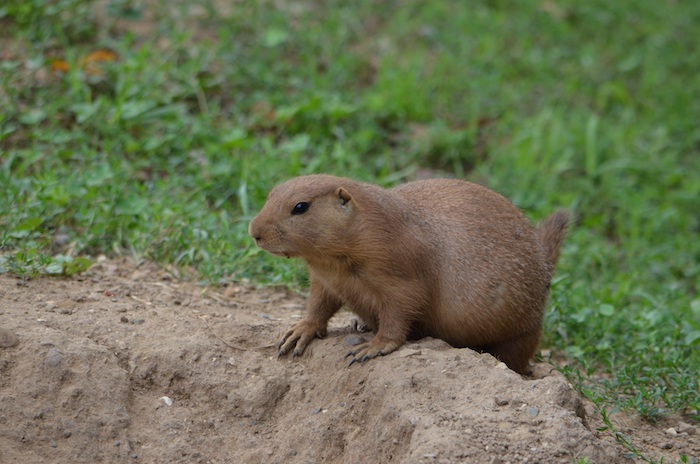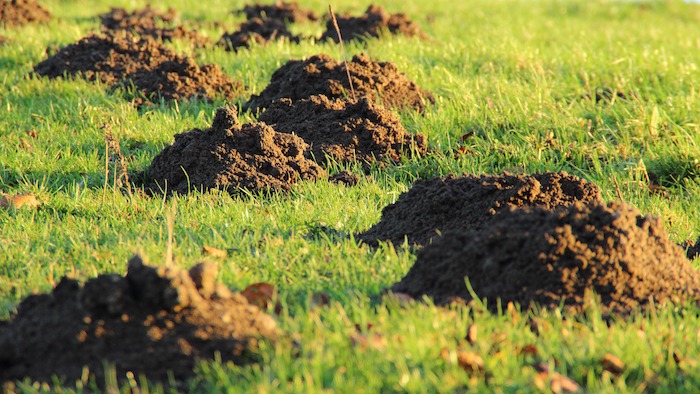
Are you tired of dealing with a myriad of tunnels and small volcanos in your yard? You might have a mole or gopher problem. But before we get started on how to exterminate these pests, it is important to note that moles can have a positive impact on the health of your lawn or garden.
They plow and aerate the soil and eat potentially harmful insects and grubs. However, while moles do not eat your plants, the tunnels that they create can certainly disturb them. A few tunnels are not a big problem, but too many can create uneven soil, ridges in your lawn or garden and a lot of molehills.
Gophers, on the other hand, DO eat plants and can wreak havoc on a lawn or garden. You can determine that you have a gopher problem by the horseshoe-shaped mounds they create. So, how do you humanely rid your property of these animals?

About Moles and Gophers
Moles can be destructive to lawns and gardens, and they affect residential properties, parks, golf courses, and cemeteries. Their burrowing activities can produce disfiguring mounds and ridges that create a bed of nutrients for weeds to germinate.
Their diet mainly consists of earthworms, beetles grubs, ants and other insects that live in the soil. They also eat seeds and vegetable matter.
Moles
There are several different mole species in the United States. The most common mole is the Scalopus aguaticus, the Eastern Mole. This mole is found across the eastern United States and causes significant damage to lawns and gardens across the country.
The most troublesome species in the northwest region of the United States is the Scapanus townsend, the Townsend mole.
The state of California is most affected by the Scapanus latimanus, the broad-footed mole. All mole species have similar biologies and modes of operation, so what works for one species is generally also useful on another.
Moles are technically not rodents. Instead, they belong to the mammal family Insectivora and are related to shrews. The Eastern mole has a pointed nose and oversized front teeth. Large claws give it the ability to create tunnels beneath the ground. Moles can be up to eight inches long with fur that looks like velvet.

Tunnels
Moles create two different types of runways (tunnels): subsurface runways and deep runways. Subsurface runways are “feeding tunnels” that are located just beneath the surface of the soil. They can be seen as raised ridges running through the lawn.
Moles can extend runways at the rate of 100 feet per day if they so choose. Subsurface runways are used on a daily basis, an irregular basis or only once before being abandoned. Subsurface runways are connected to deep runways.
Deep runways are dug at around 12 inches below the surface of the soil and are marked by the mounds found at the entrances. Subsurface tunnels are more challenging to identify as they create tiny mounds.
Moles use these deep runways on a daily basis as main travel points to get between subsurface runways or nests. The soil removed from deep tunnels is collected outside the entrance to the tunnel through short vertical pathways to create volcano-shaped mounds. Gopher mounds are similar in construction, but instead of mountain-like, they are shaped like horseshoes.
The number of mounds you see in your yard cannot be taken as a direct indication of how many moles or gophers are present. In general, one acre of land is sufficient for the needs of up to three moles at a single time. However, yards that are next to forested areas or overgrown fields may be invaded by the moles that live in these areas.

Gophers
Pocket gophers get their name from their fur-lined pouches located on each side of the face. The pouches are used for carrying food. Pocket gophers can range from five to 14 inches in length and have fine, soft fur. Colors range from black to nearly white.
The underground burrows of pocket gophers can be up to several hundred feet long and range in depth from a few inches to several feet. Gophers in northern regions tend to have a single litter per year. In southern areas, they may have up to two litters per year.
If you are looking for natural ways to get rid of moles in the yard, consider less irrigation of your soil. Both moles and gophers love moisture, so if you limit your watering schedule, the soil will not be as attractive to them for their tunneling projects.
If you have sandy soil, you are more likely to have trouble with moles and gophers. Those of you with clay soil are less likely to have problems.
There are a few homemade methods that you can use when looking at getting rid of moles and gophers. In some cases, a combination of several methods may be your best bet.

Cayenne Pepper Powder
Cayenne pepper is a spicy pepper that ranks at 30,000 to 50,000 SHU on the Scoville Scale. This product can deter multiple animal species from harming your garden or lawn.
You can sprinkle the powder directly into active holes or mix it with water to create a spray. Combined with soapy water, veggie oil and garlic, it makes an excellent insecticide and can even be used to keep pets out of your garden. To determine whether a tunnel is active or not, cover it with a little dirt and see if it is cleared away after a few days.
Smelly Things
Smelly things such as fish, rotten food, garlic, and onions can be used to keep moles and gophers at bay. Just place these things as far down tunnels as possible and see how it works.
Cats and Dogs
Cats are natural deterrents of small pests. As natural hunters, cats can help keep the population of moles and gophers down.
The smell of a cat alone could be sufficient to deter little animals from taking up residence in your yard. A dog might also have the same effect, although they do not have the same hunter instinct as cats.
Noise
Think of the Grinch here, complaining about all the “noise, noise, noise” at Christmastime. Noise-emitting devices are often used to help control pests by producing a sound that is beyond the hearing range of humans.
If you feel especially adventurous, consider placing small (weatherproof) radios or speakers down the most active tunnels. Solar powered devices that release sound signals could also be helpful. Less expensive options include glass bottles with the lids removed that are then stuck diagonally into the ground.
The wind blowing across the tops of the bottles creates vibrations that moles and gophers are sensitive to. You can also consider purchasing wind chimes or spinners that you can stick in the ground around your yard to encourage them to find greener pastures.
Oils
Certain oils are beneficial in keeping moles and gophers away, as well as decreasing grub population. Neem oil works as an indirect mole deterrent by reducing their primary source of food, grubs.
If you have a Japanese beetle problem along with a mole/gopher problem, you will be able to deliver a double punch by eliminating both the harmful beetles and the moles. However, if you are more interested in balancing the ecosystem, you can consider purchasing beneficial nematodes to combat the grubs and use a different method to discourage the mole population.
Castor oil is derived from the seeds of the castor bean plant and has been used successfully as a mole deterrent. A combination of eight ounces of castor oil with 2 T. liquid soap added to one gallon of water makes an excellent natural deterrent for moles and gophers.
Spray this solution each month over your lawn and into tunnels. Repeat this process after heavy rains. You can also consider sprinkling castor seeds around the yard as a deterrent. However, as castor seeds contain ricin, an extremely toxic poison, you’ll need to use caution when handling them. If you have pets or children, you may wish to avoid the castor seed option altogether.
Plants
Certain plants can also help to deter moles. The most commonly used is the Euphorbia lathrysi, better known by its common name, the Mole Plant. An attractive, yet poisonous plant that grows well in hardiness zones five through nine.
The Mole Plant is invasive, so you’ll want to pluck the flowers before it has a chance to go to seed. It is also poisonous so those of you with young children or pets may want to consider another plant such as chocolate lilies or garlic.

Physical Barriers
Using wire mesh can be a useful way to keep moles and voles out of your garden. For moles, you’ll want to sink the wire into the ground to a depth of 30 inches with at least six inches of height above ground.
For voles and gophers, you’ll want to increase the height to 24 inches above the ground. If it’s too expensive to do your entire garden or yard, you can consider installing a small fence around certain areas instead.
Traps
Traditional mouse traps or live traps can be washed with soapy water while wearing gloves to remove the smell. You can use peanut butter as bait. Place the trap into a mole hole or right next to it using a small box to cover it.
Be sure to place a heavy object on top to prevent the trap and box from blowing away. You can also purchase a mole trap from online or your local hardware store. Both live traps and kill traps are available.
Trapping is the most reliable of all the mole control methods. However, it also requires the most patience. Moles can detect and spring any trap that is set improperly, stealing the bait without being caught. A trap that is placed strategically tends to yield results within 24 hours.
Trapping works best when done when mole and gopher activity is at its peak in the spring and the fall. It is best if you take action to minimize damage as soon as evidence of mole activity becomes prevalent. One added benefit of spring trapping is the elimination of pregnant female moles.
As with moles, gophers can be controlled with the use of traps. The key to success is the location of active main tunnels and the correct placement. With gophers, traps placed in opposing directions at main tunnels entrances/exits will be most effective.
You can locate the main runway by probing the soil with a sharp stick or a rod one to two feet away from the burrow plug. Upon setting the trap, you will need to cover the opening with grass or cardboard to hide the disturbance. If you don’t catch anything within four days, move the traps to a new location.
Poison
If you are attempting to keep moles and gophers from harming your garden, you probably don’t want to use true poisons as a deterrent. If you are more concerned about decorative shrubbery and plants, poisons may be okay.
Be sure to use them in an area where pets and children will not have access to them. Mothballs and ammonia are two solutions that have been tried with success.
Conclusion
Gophers and moles can be a pain in the neck, but with the proper techniques, they can be controlled effectively and humanely. A combination of traps, poisons and natural deterrents can be an effective strategy against the infestation of these burrowing mammals.